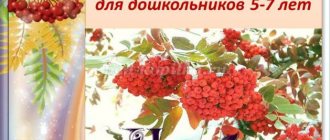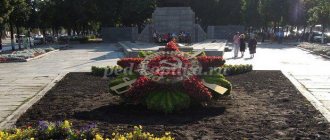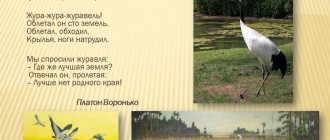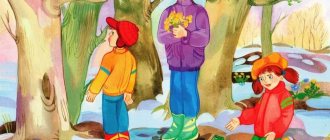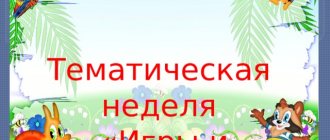Calendar-thematic planning for children of the senior group on the topic “Clothing”
Rogozhina Lyubov Evgenievna
Calendar-thematic planning for children of the senior group on the topic “Clothing”
GCD O.D. in special moments Independent
activity Individual work
1. Speech therapy.
Target. Practice pronouncing the sound “M”
.
Learn to isolate the sound “M”
from a word.
2. Physical education.
Target. Practice walking in pairs, repeat hoop climbing, practice balance and jumping.
Drawing.
Target. Develop children's to conceive the content of their drawing and bring the idea to the end. Morning. Add illustrations depicting clothes the group and invite them to consider them.
Target. Specify the names of the clothes . Encourage to name individual parts of clothing . Develop the ability to listen to children’s and complement them. Cultivate a caring attitude towards clothing .
Finger game “Grandmother the fox knits mittens for all the little foxes”
.
Target. Develop speech and fine motor skills.
Walk. Weather observation.
Target. Note the weather conditions. Talk about what natural phenomena are characteristic of autumn.
P/i “Flies or doesn’t fly”
Target. Learn to act according to the game task.
D/i “Good - bad”
Target. Learn to name what is good and what is bad in different natural phenomena
Work. Give instructions to clean up the veranda.
Target. Foster a sense of teamwork and hard work.
Evening. Reading G. Kh. Andresyan’s “The King’s New Dress”
.
Target. Teach children to listen carefully to the reading of a fairy tale and answer questions about the content. Encourage them to characterize the heroes of the fairy tale.
D/i “It was - it became”
.
Target. To clarify children’s ideas about what clothes were like before and what they are like now.
Give a task: paint a dress for a doll.
Target. Develop imagination and creative abilities. Strengthen the ability to carefully color with pencils using different degrees of pressure
Creation of conditions in d./s. games "Chauffeurs"
.
Target. Teach children to unite game plots, to reflect the relationships of people in the game.
Creating conditions for s/r. games “Dressing a doll for a walk”
.
Practice the ability to classify clothes according to seasonality. With Dima, Ksyusha, Diana on speech development. Compiling a descriptive story about clothes , shoes, hats
Dima, Sasha: learn to determine the position of the sound “O”
in a word.
D/i “Choose a word”
With Angelina, Dima.
Target. Learn to select synonyms.
Ind work with Sasha, Ksyusha, Angelina
D/i “Who can name the most items of clothing ”
Target. Expand words knowledge
Tuesday
1. Musical. (According to plan )
.
2. Familiarization with the surroundings.
Topic: “National Unity Day”
.
Target. Introduce children to the holiday “National Unity Day”
, the history of its origin.
To foster civic and patriotic feelings, love of the motherland and respect for national heroes. Develop children's by expanding their understanding of the phenomena of social life.
3 Modeling.
Topic: “Make a toy”
.
Target. Create an image of your favorite toy in sculpting. Strengthen sculpting techniques: rolling plasticine between the palms with straight and circular movements, connecting individual parts.
Morning. Watching the snow and passers-by from the window. Pay attention to the clothing of pedestrians . the names of clothes in children's speech .
P/i “Traffic Light”
Target. Develop attention, dexterity, reaction speed
D/i “What color is gone”
Target. Determine and accurately name the color of objects and their shades.
Bring paper dolls into the group and offer to draw clothes .
Target. Develop artistic abilities.
Walk. Observation "The Power of the Wind"
Target. Continue to introduce children to the concept of “Wind Power”
. Develop skills for safe behavior during strong winds.
P/i “Bird and Cat”
.
Target. Teach children to move in accordance with the text of the game, pay attention to the need to be attentive, move carefully, avoid collisions, create a joyful emotional mood.
Work. Clear the paths of snow.
Target. Foster hard work and responsibility.
Evening. P/i “New sneakers are dancing”
Target. Learn to speak the words of the game and perform movements according to the text of the game. Develop speech and attention.
Read N. Nosov “Living Hat”
Target. Encourage answering questions based on content. Learn competently, build sentences.
Work. Give the task to wash clothes for the dolls .
Target. Cultivate a desire to keep toys clean,
hard work. S/r. game “ Clothing ”
Target. Using the indirect method of guidance, lead to the independent creation of game ideas, use knowledge about items of clothing .
S/s at the request of the children .
Target. Unite in the game, distribute roles. Individual work with Diana, Sasha, Ksyusha
Word game: I’ll come up with words with the sounds “M”
Individual work with Svyatoslav, Dima “Find the extra”
on the topic of
clothing .
Target. Develop attention and thinking.
Individual work with Anton “finish the sentence”
Target. Develop grammatical structure of speech.
Wednesday
1. Speech therapy.
Learn to distinguish between hard and soft sounds. Teaches how to distinguish the hard and soft sound “m”
from the composition of the word. Introduce analysis and synthesis.
Getting to know your surroundings.
Topic: “Saiga - steppe antelope”
.
Target. Enrich children's knowledge on the topic Saiga : an even-toed ungulate, herbivore animal that lives in the steppes. Deepen knowledge about the habitat and the protection of animal life.
3. Drawing.
On the topic : "Saiga"
Target. Learn to draw an animal, maintain proportions, place the drawing in the center of the sheet. Strengthen the ability to work with watercolors, mix paints. Morning. Consider illustrations with children: clothing of primitive people .
Target. Introduce children to the history of clothing .
Talking to Children: How to Handle Your Clothes .
Target. Cultivate a caring attitude towards clothing .
Finger game “Once upon a time there lived a skilled tailor”
.
Target. Develop speech and fine motor skills.
Walk. Observation of air properties.
Target. To help children, in the process of observation, confirm their knowledge that the air has no smell, taste, color, and can be of different temperatures (in the fall the air becomes cold, in the summer the air is warmer)
.
To form in children the idea that air is needed by all living things on earth, that air surrounds us everywhere (there is air in both water and soil)
P/i ""
Mice and cat"
Target. Teach children to subordinate their actions to the leader’s signals, concentrate attention, and train children to run while changing the direction and pace of movement. Arouse positive emotions when conducting outdoor games. Develop activity in outdoor games.
Labor.Give an order: hang up the feeders.
Target. To cultivate a desire to take care of birds and to treat them with care.
Evening. Ice experiment.
Bring to the conclusion that ice is lighter than water, therefore it does not sink, but floats on its surface.
Role-playing game "Atelier"
.
Target. Promote joint creative play and role-playing dialogue.
Reading Ushinsky K. “How a shirt grew in a field”
Target. Develop curiosity and expand your horizons. children's vocabulary . Didactic game “Pick a patch to your clothes ”
.
Target. Develop attention and memory
Game exercise “Catch the ball”
.
Target. Strengthen children's to throw and catch the ball, take the correct starting position, hold the ball with both hands in front of them, throw with a push from the chest, straightening the pushing leg and arms, and return to the starting position.
Printed board game "Loto"
on
the topic : Clothes .
Target. Develop attention, speech, memory, thinking. Individual work with Angelina, didactic game “Find out who it is?”
Target. Teach to recognize children , groups by describing clothes , activate in children’s concepts associated with items of clothing , primary colors
Individual work with Nikita.
Target. Learn to long jump and strengthen your leg muscles.
Individual work with Lera: make an origami craft “Dress”
Target. Continue to learn how to fold paper in different directions, develop speech, imagination, and accuracy.
Thursday
1 Physical education.
Target. Exercise in balance, developing coordination of movement, in jumping, learn to throw balls in lines
2. Mathematics
Target. Learn to count within 9; show the formation of number 9. Consolidate knowledge about geometric shapes: circle, square, triangle, rectangle Morning. Didactic game “It was - it became”
.
Target. To clarify children’s ideas about what clothes were like in the past and what they are like now
Conversation on the fairy tale “Cinderella”
Target. Learn to negotiate the need for a certain outfit for different places
Household work: wiping down the cabinet shelves.
Target. Perform this work operation, talk about its purpose, support the desire to complete the work started
Walk. Weather observation.
Weather observation
Target. Refine your knowledge of weather characteristics. Develop the ability to describe her condition, based on the teacher’s questions
P./i "Horses"
Target. Learn to act in accordance with the rules, control your actions, compare them with the actions of your partner when moving in pairs; increase children's
Work. Encourage children to clear paths .
Target. Foster a sense of teamwork, hard work, and responsiveness.
Evening. Drawing "Dress"
Target. Teaches how to paint a ready-made dress template using the color scheme and pattern elements characteristic of folk dresses.
Reading C. Perrault “Little Red Riding Hood”
Target. Continue to cultivate a love of fairy tales. Encourage answering questions based on content. Describe the characters of the fairy tale. Cultivate courage and responsiveness.
S/r game “Studio for dolls”
.
Target. Teach children to unite in a game , distribute roles, act in accordance with the rules and the general game plan. Construction games according to plan.
Target. Learn on your own, come up with the content of the building, and select the necessary parts. Develop constructive skills and abilities
Game activities based on children's .
Target. independence in , and to develop the ability to spend leisure time interestingly and usefully.
Labor.Give an order: glue the books.
Target. Strengthen the ability to work with scissors and carefully glue. Foster a caring attitude towards books Individual work with Diana, Maxim: play the word game “What kind of clothes ?”
Target. Practice the ability to form forms of adjectives.
Individual work with
with Andrey game exercise “Walk on the bridge”
Target. Learn to walk on a bench while maintaining balance, develop coordination of movements, increase motor activity, and cultivate perseverance in achieving a given result.
Individual work with Dima D.: fix the quantitative score within 9
Friday
1Musical (according to the music director’s plan )
.
2 Speech development. Compiling the story “How I went to the forest”
Target. Expand your understanding of the diversity of the plant world. Talk about the species diversity of forests. Activate the words in children's : deciduous, coniferous, mixed. Learn to name the distinctive features of trees and shrubs Morning . D/i “Who can name more items of clothing ”
Target. Expand words knowledge
Conversation reasoning “If there were no clothes ”
.
Target. Encourage children to reason and formulate conclusions. Develop grammatically correct speech
D/i “Dress for the season”
Target.
Activate the words in children's : off-season, winter, summer, men's, women's, children's clothing . Enrich children's
Walk. Observing the shape of snowflakes.
Target. children’s knowledge about the three states of water. Invite children to catch a snowflake in their hand and examine it, draw children's attention to the fact that snowflakes come in different shapes. Teach children to notice the beauty of inanimate nature.
The game “Who is good?”
Target. Help children overcome shyness, isolation, stimulate activity.
P/i “Airplanes”
Target. Exercise children in spatial orientation, running in teams across the entire playground, teach them to monitor their posture during movements, and develop attention.
Work. Instruct the children to clear the area.
Target. To cultivate such qualities as mutual assistance, mutual assistance, and hard work.
Evening. D/i “Wear a cookie for a walk”
Target. Reinforce the classification of clothing .
Read N. Nosov “Patch”
Target. Cultivate a caring attitude towards clothing . Teach competently, answer questions according to the content.
Construction games: “Building a studio”
Target. Teach children to build tall buildings with ceilings, to make the building strong by placing heavier parts at the base. Teach children , using a model, to determine from what parts the individual parts of the building are made, and in what sequence to carry it out. Cultivate friendly relationships, learn to negotiate interactions.
Browse fashion magazines.
The goal is to expand children's knowledge about clothing .
Labor activity. Building a slide for a doll.
Target. Teach children to act in concert, collectively, independently choose equipment for work, and agree on interaction.
Free drawing.
Target. Continue to introduce the colors of the spectrum, teach how to select the necessary equipment to implement your plans. Individual work with Ksyusha, articulation gymnastics. Exercise "Focus"
Target. Help improve the movements of the articulatory apparatus. Teach children to correctly pronounce sounds in different word constructions
Comprehensive thematic planning of educational activities. on topic: "Clothing"
Transcript
1 Comprehensive thematic planning of educational activities on the topic: “Clothing” Goal: Expand, generalize, systematize children’s ideas about clothing and its purpose. Objectives: 1. Educational. To form children’s ideas about clothing, its types, parts; ; teach children to generalize, classify, systematize. 2. Developmental. Enrichment and updating of predicative and attributive vocabulary, development of dialogic speech. 3. Educational. Cultivate a caring attitude towards clothing. Final event: Exhibition of clothing models.
2 Joint activity of children and adults Directly educational Educational activity during regime moments Cognitive activity Clarify children’s vocabulary on the topic, expand and intensify it. Introduce the purpose of clothing. Learn to make action proposals; learn to use the diminutive form of nouns; develop attention, memory, thinking, general motor skills. Game exercise: “Let’s help the doll”, “What is this”. Game “Dress the doll”, “What does the doll have, what does the doll have” Fizminutka Music. Cognitive activity FEMP (as an independent MONDAY Morning exercises: Conversation “Our clothes” Purpose: to enrich children’s ideas about the purpose of clothing, its seasonality; remember the name of its parts, color, shape. Observation of the sky in autumn. P/I “Traffic light” Purpose: to exercise children running, teach to follow the rules Gymnastics after sleep: Finger gymnastics D/I “Who is wearing what?” Purpose: to develop children’s powers of observation, visual memory, to activate vocabulary on the topic. TUESDAY Independent activity of children Album for viewing “Clothes” Game “ Dress a doll" (felt doll and a set of clothes for her) Replenishing the corner with a plot Interaction with children's families on the implementation of the educational program of preschool education Consultation "How to dress in late autumn" Involving parents in the design of an album for the atelier "Fabric samples" Exhibition of children's work together
Unit 3): “Orientation in space” to develop the ability to navigate in space (up and down, right to left, back and forth); learn to distinguish between parts of the day and select appropriate clothing; select clothes according to geometric shapes; develop speech and mental operations. Game "Fourth wheel"; “Find and paint over”, “Collect the cut-out picture “Jacket””. Exercise “Find and answer”, “Place it correctly”. Physical minute “Up and down, right to left, back and forth” Speech therapy lesson: according to the speech therapist’s plan. Fine art “Jacket for Masha” Goal: improve the skill of drawing with crayons, do your work carefully, learn how to detail an image, and clean up your workplace. Conversation “Who will sew our clothes” Purpose: to introduce children to the profession of a seamstress, with the items she needs for work. Observing the behavior of a crow. P/I “Thread and Needle” Purpose: to learn to walk in a column one at a time, without overtaking those in front and without falling behind. Labor assignment: collecting twigs for crafts. Gymnastics after sleep: Puppet theater “Rukavichka” Purpose: to develop the ability to follow the course of events, memorize the characters of a fairy tale. Help prevent emotional stress. WEDNESDAY Conversation “Dress for the weather” Purpose: to introduce children to the purpose and functions of clothing items necessary for human life. Observing passers-by who is dressed. P/N “1,2,3,4,5! We need to quickly run into the circle (for those who have pockets on their jackets, etc.)” role-playing games “Atelier” Bi-ba-bo dolls for the theatrical production “Mitten”. Stencils on the topic “Clothing” Coloring pages, educational for parents “Get dressed for a walk in the fall.” Consultations on parenting issues. Involving parents in the preparation and design of an exhibition of clothing models.
4 Application “Decorate the mitten” Purpose: to teach children to place shapes on paper, carefully stick them on; develop speech and thinking; consolidate knowledge about geometric shapes; develop creative activity and fine motor skills. Speech therapy lesson: according to the teacher’s plan. Purpose: to practice running, teach to understand and follow instructions. S/r game “Clothing Store” Purpose: to generalize and systematize the gaming experience of children, to encourage them to use knowledge about items of clothing and their purpose in the game. THURSDAY Conversation “Why do we need clothes” Goal: to expand and concretize ideas about clothing, its purpose, the details of which it consists. Watching snowfall. P/I “Traffic Light” Purpose: to train children in running, to teach them to follow the rules Labor assignment: to restore order in the area. Reading the story “Masha Confused” by L. Voronkova Purpose: to encourage children to listen carefully to Samples of different types of fabric for viewing and examination. Consultation for parents “Speech games on the topic “Clothing” on the way home.” Decorating dolls with sets of clothes according to the seasons.
5 Fine art “Hat for a Bear” to develop the ability to draw straight and wavy lines; strengthen skills in working with paint and brush; develop children’s ideas about the arrangement of elements on the cap (vertically, horizontally, obliquely); development of fine motor skills of hands, thinking, attention; nurturing a positive attitude towards visual activity and the results of one’s work. Music. work, correlate with illustrations; anwser the questions. FRIDAY D/I “What did the artist forget to draw?” Goal: practice changing nouns in the genitive case singular and plural; development of visual perception and attention. Excursion to the laundry “Conversation with a worker about washing clothes” P/I “Who is wearing what” Purpose: to practice running, teach to understand and follow instructions. D/game “Describe, I’ll guess” Goal: to enrich and update the vocabulary of signs, to teach children to identify and name the essential features of objects. Replenishing the theater corner with items of clothing for viewing and trying on. Exhibition of children's works on the topic. Design for the “Find a Pair” d/i.
Planning educational work in the senior group “Clothing. Shoes. Hats"
Planning educational work.
Theme of the month, week, day (Monday) “Clothing. Shoes. Hats".
Time
Joint activities between adults and children
Independent activities of children
Interaction with specialists, parents, social partners
Group, subgroup
individual
Morning
Morning exercises.
Conversation: “The tramp wind turns the weather.”
Objectives: to form children’s ideas about the relationship between weather phenomena and clothing.
Looking at photographic illustrations of clothing.
Individual work on speech development. Didactic game “On the contrary” (Timofey, Dima, Seryozha).
Objectives: develop the ability to compare objects by size (length, width), coordinate adjectives with nouns in gender, number, and select antonyms.
Household work: cleaning the group room.
Objectives: to teach how to organize joint work, to form responsibility for fulfilling work assignments.
Parents are recommended:
- remind the child what time of year it is; pay attention to the weather;
- tell your child about spring clothes, hats and shoes, and their purpose;
- pay attention to the material from which they are made, quality, distinctive features in comparison with summer or winter clothes and shoes;
— as an excursion, it is advisable to visit shops where they sell various fabrics, and ateliers for sewing clothes and hats.
Organized educational activities
Development of speech “Sounds “G-K”, coloring objects, modeling, listening to nursery rhymes.
Goal: to promote the development of phonemic hearing, to distinguish consonant sounds “G-K”. Continue to develop the ability to name the first sound in words. Develop graphic skills (shading). Develop the ability to read a nursery rhyme expressively. Develop active speech. To develop the skill of self-control and self-esteem (E.V. Kolesnikova “From Word to Sound”, p. 60).
Drawing “Girl in a smart dress.”
Purpose: to teach children to draw a human figure; convey the shape of the dress, the shape and arrangement of parts, their ratio in size more accurately than in previous groups. Continue learning to draw large, on the entire sheet. Reinforce the techniques of drawing and shading drawings with pencils (T.S. Komarova, p. 48).
Walk
Observation of plants.
Objectives: draw children’s attention to the fact that near the tree trunks the snow begins to melt and thawed patches are visible.
Outdoor games “Counter dashes”, “Entertainers”.
Objectives: continue to teach how to follow the rules of the game;
intensify physical activity.
Labor: clearing snow on site.
Individual work on
development of movements. Game exercise “Top” (Sonya, Dasha N., Danya Kh., Lesha).
Objectives: teach children to spin on the spot in pairs, holding hands. Develop the vestibular apparatus of children.
Didactic game "Live Week".
Objectives: to consolidate children’s knowledge about the sequence of days of the week.
Sports game football.
Objectives: teach children to play together and act as one team. Promote the development of accuracy, coordination of movements, determination, courage.
Independent games for children with external materials.
Preparing for lunch. Dinner.
Preparation for sleep.
Reading the story by K. Ushinsky “How a shirt grew in a field.”
Objectives: teach children to listen to the reader, understand the content of what they read, answer questions about the content.
Canteen duty
(Danya P.).
Objectives: to cultivate responsibility, conscientiousness, and develop teamwork skills.
Game situation “Handkerchief”.
Objectives: teach children to monitor the condition of their nose and mouth, and use a handkerchief when coughing and sneezing.
Afternoon/evening
Wellness activities after sleep: awakening gymnastics, walking along massage paths.
Conversation “Symbols of the Russian Federation.”
Objectives: to consolidate children’s knowledge about the Russian flag. Introduce the state emblem and anthem of Russia.
Didactic game “What’s mixed up” (Nikita V., Sasha, Olya).
Objectives: consolidate ordinal counting skills, develop visual perception, memory, attention.
Coloring illustrations from coloring books.
Role-playing game "Atelier".
Objectives: to improve children’s ability to unite in a game, distribute roles, and perform game actions in accordance with the game plan.
Organized educational activities
Physical education (according to the plan of the physical director)
Walk
Animal observation.
Objectives: discuss with the children what animals can be seen in the kindergarten area, what groups they can be classified into (birds, animals).
Outdoor game "Traps".
Objectives: to develop in children the ability to concentrate and distribute attention, act on a signal, develop coordination of movements, and dexterity.
Dinner
Didactic game "Toy Store".
Objectives: to develop the ability to classify objects according to given characteristics. Develop children's logical thinking.
Planning educational work.
Theme of the month, week, day (Tuesday) “Clothing. Shoes. Hats".
Time
Joint activities between adults and children
Independent activities of children
Interaction with specialists, parents, social partners
Group, subgroup
individual
Morning
Morning exercises.
Conversation on the topic “The invention of the needle.”
Objectives: to introduce children to the evolution of the needle from antiquity to the present day.
Examination of photo illustrations depicting clothes and shoes.
Articulation gymnastics “Puffing up our cheeks”, “Delicious jam”, “Cup” (Dasha F., Egor, Dima).
Objectives: to train the articulatory apparatus of children.
Class duty (Julia).
Objectives: teach children to perform the duties of a duty officer, instill responsibility.
Independent activity of children in the theater corner.
Objectives: to develop children's independence, initiative, and creative abilities.
Tips for parents on organizing games with basic mathematical calculations. Providing methodological recommendations for playing games with counting elements.
Organized educational activities
Cognitive development (FCCM) “Our clothes. Seasonal clothing."
Goal: develop oral speech; clarify the functional significance of clothing in people’s lives: the need for clothing is inherent only to people; teach to differentiate clothes by season; give the concept of national clothing and give examples (N.E. Veraksa “Comprehensive Lessons”, p. 95).
Modeling “Little Red Riding Hood brings gifts to grandma.”
Goal: to teach children to create images of fairy-tale characters in modeling. Strengthen the ability to depict a human figure, convey the characteristic features and details of the image. Practice using a variety of modeling techniques. Teach figurative evaluation of your own work and the work of other children. Develop imagination (T.S. Komarova, p. 108).
Music (according to the music director's plan)
Walk
Weather observation.
Objectives: to strengthen children’s ability to independently determine the weather, name its main characteristics: cloudiness, temperature, precipitation, wind.
Outdoor games “Homeless Hare”, “Sly Fox”.
Objectives: teach children to follow the rules of the game, play the roles of players and driver-trap. Increase children's physical activity.
Labor: clearing the area of branches.
Individual work on
development of movements (Olya, Ulyana, Misha).
Objectives: improve walking technique (walking with an extended step).
Game exercise “Fighter planes”.
Objectives: to train children in running, changing the pace of movement at a signal, to teach them to run across the entire playground, and to avoid collisions.
A health jog around the kindergarten.
Objectives: teach children to correctly perform basic movements when running, maintain posture, coordinate the movements of arms and legs, breathe rhythmically through the nose.
Independent games of children's choice.
Preparing for lunch. Dinner.
Preparation for sleep.
Reading and discussion of Z. Alexandrova’s story “Sarafan.”
Objectives: to develop artistic perception and aesthetic taste, to develop literary speech.
Canteen duty (Nikita K.).
Objectives: discuss with children the significance of the work being performed, teach them to plan their actions, stick to the plan, talk about the results of the work, evaluate its quality.
Formation of a culture of behavior.
Objectives: discuss with children why people say hello to each other, form the habit of saying hello to parents and teachers, and saying goodbye when going home.
Afternoon/evening
Wellness activities after sleep: awakening gymnastics, walking along massage paths.
Dramatization game according to r.n.s. "The Fox, the Hare and the Rooster."
Objectives: to teach children to select means of expression in accordance with the characters’ characters, to convey images in movement, facial expressions, gestures, and intonations.
Didactic game “Long, wide” (Seryozha, Lesha, Polina).
Objectives: to consolidate the ability to compare the length and width of objects using a conventional measure. Improve design skills.
The use of strokes and shading, patterns and stencils of clothing.
Independent gaming activity: board games.
Objectives: teach children to choose a game based on their interests, select partners for the game, and independently select a place to play.
Role-playing games of children's choice.
Walk
Observation of icicles.
Objectives: invite children to tell how icicles “grow” and watch how they melt. Explain why icicles “cry” on a warm day.
Outdoor game "Owl".
Objectives: to develop the ability to act on a signal, to train children in running. Develop attention, coordination of movements, agility and endurance.
Dinner
Didactic game "Finish the sentence."
Objectives: to develop the ability to understand causal relationships between phenomena, to develop children’s speech, creative thinking, and imagination.
Independent play activities of children.
Planning educational work.
Theme of the month, week, day (Wednesday) “Clothing. Shoes. Hats".
Time
Joint activities between adults and children
Independent activities of children
Interaction with specialists, parents, social partners
Group, subgroup
individual
Morning
Morning exercises.
Conversation on the topic “Minin and Pozharsky.”
Objectives: introduce children to...
